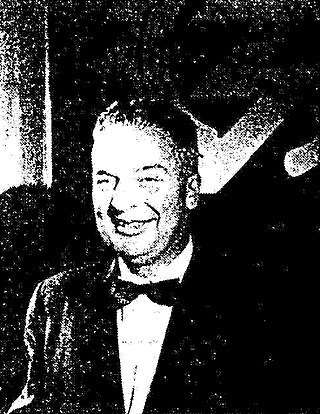
The 16th Street Baptist Church bombing was a terrorist bombing of the 16th Street Baptist Church in Birmingham, Alabama on September 15, 1963. The bombing was committed by a white supremacist terrorist group. Four members of a local Ku Klux Klan (KKK) chapter planted 19 sticks of dynamite attached to a timing device beneath the steps located on the east side of the church.

Leo Max Frank was an American factory superintendent and lynching victim. He was convicted in 1913 of the murder of a 13-year-old employee, Mary Phagan, in Atlanta, Georgia. Frank's trial, conviction, and unsuccessful appeals attracted national attention. His kidnapping from prison and lynching became the focus of social, regional, political, and racial concerns, particularly regarding antisemitism. Modern researchers generally agree that Frank was wrongly convicted.

Jesse Benjamin Stoner Jr. was an American lawyer, white supremacist, neo-Nazi, segregationist politician, and domestic terrorist who perpetrated the 1958 bombing of the Bethel Baptist Church in Birmingham, Alabama, but was not convicted for the bombing of the church until 1980.

Richard Allensworth Jewell was an American security guard and law enforcement officer who alerted police during the Centennial Olympic Park bombing at the 1996 Summer Olympics in Atlanta, Georgia. He discovered a backpack containing three pipe bombs on the park grounds and helped evacuate the area before the bomb exploded, saving many people from injury or death. For months afterward he was suspected of planting the bomb, resulting in adverse publicity that "came to symbolize the excesses of law enforcement and the news media".

The National States' Rights Party was a white supremacist political party that briefly played a minor role in the politics of the United States.

Temple Beth-El is a Conservative synagogue located in Birmingham, Alabama, in the United States. Founded in 1907, Temple Beth-El is a member of the United Synagogue of Conservative Judaism. Temple Beth-El is the only Conservative-affiliated synagogue in Birmingham, and one of only four Conservative synagogues in Alabama.

Joachim Prinz was a German-American rabbi who was an outspoken activist against Nazism in Germany in the 1930s and later became a leader in the civil rights movement in the United States in the 1960s.

Melissa Fay Greene is an American nonfiction author. A 1975 graduate of Oberlin College, Greene is the author of six books of nonfiction, a two-time National Book Award finalist, a 2011 inductee into the Georgia Writers Hall of Fame, and a 2015 recipient of the John Simon Guggenheim Fellowship in the Creative Arts. Greene has written for The New Yorker, The New York Times, The Washington Post, New York Magazine, Newsweek, Life Magazine, Good Housekeeping, The Atlantic, Reader's Digest, The Wilson Quarterly, Redbook, MS Magazine, CNN.com and Salon.com.
The Double Jeopardy Clause of the Fifth Amendment to the United States Constitution provides: "[N]or shall any person be subject for the same offence to be twice put in jeopardy of life or limb..." The four essential protections included are prohibitions against, for the same offense:

The Temple is a Reform Jewish congregation and synagogue located at 1589 Peachtree Street NE, in Atlanta, Georgia, in the United States. The oldest Jewish congregation in Atlanta, it was established in 1860 to serve the needs of German-Jewish immigrants. The Temple, designed by Philip Trammell Shutze in a Neoclassical style, was completed in 1931.

Congregation Beth Israel is a Reform Jewish congregation and synagogue, located in Meridian, Mississippi, in the United States. Founded in 1868 and a member of the Union for Reform Judaism, the congregation's first permanent house of worship was a Middle Eastern-style building constructed in 1879. The congregation moved to another building built in the Greek Revival style in 1906, and in 1964 moved to a more modern building, out of which they still operate.
African Americans and Jewish Americans have interacted throughout much of the history of the United States. This relationship has included widely publicized cooperation and conflict, and—since the 1970s—it has been an area of significant academic research. Cooperation during the Civil Rights Movement was strategic and significant, culminating in the Civil Rights Act of 1964.
Lemrick Nelson, Jr. is a Trinidadian man who stabbed Hasidic student Yankel Rosenbaum to death during the racial unrest of the 1991 Crown Heights riot. Though his lawyer did not deny at his trial that Nelson stabbed Rosenbaum, he argued that the killing had nothing to do with Rosenbaum's being Jewish.
The history of the Jews in Atlanta began in the early years of the city's settlement, and the Jewish community continues to grow today. In its early decades, the Jewish community was largely made up of German Jewish immigrants who quickly assimilated and were active in broader Atlanta society. As with the rest of Atlanta, the Jewish community was affected greatly by the American Civil War. In the late 19th century, a wave of Jewish migration from Eastern Europe brought less wealthy, Yiddish speaking Jews to the area, in stark contrast to the established Jewish community. The community was deeply impacted by the Leo Frank case in 1913–1915, which caused many to re-evaluate what it meant to be Jewish in Atlanta and the South, and largely scarred the generation of Jews in the city who lived through it. In 1958, one of the centers of Jewish life in the city, the Hebrew Benevolent Congregation, known as "The Temple" was bombed over its rabbi's support for the Civil Rights Movement. Unlike decades prior when Leo Frank was lynched, the bombing spurred an outpouring of support from the broader Atlanta community. In the last few decades, the community has steadily become one of the ten largest in the United States. As its population has risen, it has also become the Southern location of many national Jewish organizations, and today there are a multitude of Jewish institutions. The greater Atlanta area is considered to be home to the country's ninth largest Jewish population.

This timeline of antisemitism chronicles the facts of antisemitism, hostile actions or discrimination against Jews as a religious or ethnic group, in the 20th century. It includes events in the history of antisemitic thought, actions taken to combat or relieve the effects of antisemitism, and events that affected the prevalence of antisemitism in later years. The history of antisemitism can be traced from ancient times to the present day.

Congregation Anshai Emeth is a Reform Jewish congregation and synagogue located at 5614 North University Street, in Peoria, Illinois, in the United States. Established in 1859, the synagogue is the second oldest Jewish congregation in Illinois, and as of 2019 has the largest membership of any Jewish congregation in Peoria.
The Otherside Lounge bombing was a domestic terrorist pipe bombing attack that occurred on February 21, 1997, in Atlanta, Georgia, United States. At approximately 9:45 p.m., a bomb exploded at the Otherside Lounge lesbian bar that damaged the building and destroyed several cars in the parking lot. While no one was killed, five people were injured, including one critically injured patron. The bombing had been carried out by Eric Rudolph, a serial bomber who had previously committed the Centennial Olympic Park bombing in 1996 that was responsible for two deaths, and he had targeted the nightclub due to his strong opposition to the gay rights movement. In the aftermath of the bombing, investigators were able to link the bombing to the Centennial Olympic Park bombing and to a nearby bombing of an abortion clinic. Several months later, following a bombing of an abortion clinic in Birmingham, Alabama, officials were able to link Rudolph to all four bombings and, following a largescale manhunt, he was arrested in 2003 and sentenced to life in prison in 2005. The nightclub, which had been in operation since 1990, never fully recovered from the incident and closed two years after the bombing.
The Ministers' Manifesto refers to a series of manifestos written and endorsed by religious leaders in Atlanta, Georgia, United States, during the 1950s. The first manifesto was published in 1957 and was followed by another the following year. The manifestos were published during the civil rights movement amidst a national process of school integration that had begun several years earlier. Many white conservative politicians in the Southern United States embraced a policy of massive resistance to maintain school segregation. However, the 80 clergy members that signed the manifesto, which was published in Atlanta's newspapers on November 3, 1957, offered several key tenets that they said should guide any debate on school integration, including a commitment to keeping public schools open, communication between both white and African American leaders, and obedience to the law. In October 1958, following the Hebrew Benevolent Congregation Temple bombing in Atlanta, 311 clergy members signed another manifesto that reiterated the points made in the previous manifesto and called on the governor of Georgia to create a citizens' commission to help with the eventual school integration process in Atlanta. In August 1961, the city initiated the integration of its public schools.












